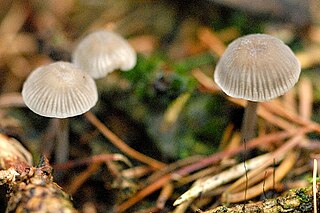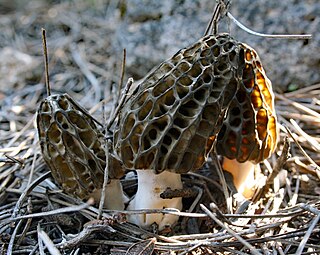
An oak is a hardwood tree or shrub in the genus Quercus of the beech family. They have spirally arranged leaves, often with lobed edges, and a nut called an acorn, borne within a cup. The genus is widely distributed in the Northern Hemisphere; it includes some 500 species, both deciduous and evergreen. Fossil oaks date back to the Middle Eocene. Molecular phylogeny shows that the genus is divided into Old World and New World clades, but many oak species hybridise freely, making the genus's history difficult to resolve.

Rubroboletus satanas, commonly known as Satan's bolete or the Devil's bolete, is a basidiomycete fungus of the bolete family (Boletaceae) and one of its most infamous members. It was known as Boletus satanas before its transfer to the new genus Rubroboletus in 2014, based on molecular phylogenetic data. Found in broad-leaved and mixed woodland in the warmer regions of Europe, it is classified as a poisonous mushroom, known to cause violent gastroenteritis. However, reports of poisoning are rare, due to the striking coloration and unpleasant odor of the fruiting bodies, which discourage experimentation.

Tylopilus is a genus of over 100 species of mycorrhizal bolete fungi separated from Boletus. Its best known member is the bitter bolete, the only species found in Europe. More species are found in North America, such as the edible species T. alboater. Australia is another continent where many species are found. All members of the genus form mycorrhizal relationships with trees. Members of the genus are distinguished by their pinkish pore surfaces.

Boletus aereus, commonly known as the dark cep, bronze bolete, or queen bolete, is a highly prized and much sought-after edible mushroom in the family Boletaceae. The bolete is widely consumed in Spain, France, Italy, Greece, and generally throughout the Mediterranean. Described in 1789 by French mycologist Pierre Bulliard, it is closely related to several other European boletes, including B. reticulatus, B. pinophilus, and the popular B. edulis. Some populations in North Africa have in the past been classified as a separate species, B. mamorensis, but have been shown to be phylogenetically conspecific to B. aereus and this taxon is now regarded as a synonym.

Amanita altipes, also called the yellow long-stem amanita, is a species of agaric fungus found in coniferous woodlands in southwestern China.

Amanita orientifulva, also known as the Asian orange-brown ringless amanita, is a species of agaric fungus that fruits singly or scattered from June to September.

Exsudoporus frostii, commonly known as Frost's bolete or the apple bolete, is a bolete fungus first described scientifically in 1874. A member of the family Boletaceae, the mushrooms produced by the fungus have tubes and pores instead of gills on the underside of their caps. Exsudoporus frostii is distributed in the eastern United States from Maine to Georgia, and in the southwest from Arizona extending south to Mexico and Costa Rica. A mycorrhizal species, its fruit bodies are typically found growing near hardwood trees, especially oak.

Mycena cinerella, commonly known as the mealy bonnet, is an inedible species of mushroom in the family Mycenaceae. It is found in Europe and the United States, where it grows in groups on fallen leaves and needles under pine and Douglas fir. The small grayish mushrooms have caps that are up to 1.5 cm (0.6 in) wide atop stipes that are 5 cm (2.0 in) long and 2.5 mm (0.10 in) thick. Its gills are grayish-white and adnate, with a "tooth" that runs slightly down the stipe. The fungus has both two- and four-spored basidia. As its common name suggests, it smells mealy.
Zangia is a genus of bolete fungi in the family Boletaceae. The genus, circumscribed in 2011, contains six species found in China. Zangia species grow in forests dominated by Fagaceae mixed with Pinaceae (pines).

Amanita parcivolvata also known as ringless false fly amanita, is a fungus that produces fruit bodies ranging from 3–12 centimetres in width and height.

Morchella tridentina is a cosmopolitan species of ascomycete fungus in the family Morchellaceae. Commonly referred to as the mountain blond or western blond morel in North America, it produces conical, grey to buff fruit bodies that are rufescent and grow up to 20 cm (7.9 in) tall and 5 cm (2.0 in) wide. This early-diverging species is distinct within the /Elata clade due to its pale colours and has been described by many names in the past, including M. frustrata, M. quercus-ilicis, M. elatoides, M. elatoides var. elegans and M. conica var. pseudoeximia, all of which were shown to be synonyms. A widely distributed relict of the last Ice Age, M. tridentina is so far known from Argentina, Armenia, Chile, Cyprus, France, India, Israel, North America, Spain and Turkey.

Picipes badius, commonly known as the black-footed polypore or black-leg, is a species of fungus in the family Polyporaceae. It causes a white rot of hardwoods and conifers. The species is found in temperate areas of Asia, Australia, Europe, and North America. It has a dark brown or reddish-brown cap that reaches a diameter of 25 cm (9.8 in), and a stipe that is often completely black or brown at the top and black at the base.

Calostoma cinnabarinum, commonly known as the stalked puffball-in-aspic,gelatinous stalked-puffball, or red slimy-stalked puffball, is a species of gasteroid fungus in the family Sclerodermataceae, and is the type species of the genus Calostoma. The fruit body has a distinctive color and overall appearance, featuring a layer of yellowish jelly surrounding a bright red, spherical head approximately 2 centimeters (0.8 in) in diameter atop a red or yellowish brown spongy stipe 1.5 to 4 cm tall. The innermost layer of the head is the gleba, containing clear or slightly yellowish elliptical spores, measuring 14–20 micrometers (μm) long by 6–9 μm across. The spore surface features a pattern of small pits, producing a net-like appearance. A widely distributed species, it grows naturally in eastern North America, Central America, northeastern South America, and East Asia. C. cinnabarinum grows on the ground in deciduous forests, where it forms mycorrhizal associations with oaks.

Harrya is a fungal genus in the family Boletaceae. It was circumscribed in 2012 to contain the species Harrya atriceps and the type Harrya chromapes.

Imperator luteocupreus is a species of bolete fungus in the family Boletaceae. It is native to southern Europe, where it is found under chestnut (Castanea) and oak (Quercus). Although it was originally described in genus Boletus, it was placed in the new genus Imperator in 2015, based on phylogenetic inferences.

Harrya chromapes, commonly known as the yellowfoot bolete or the chrome-footed bolete, is a species of bolete fungus in the family Boletaceae. The bolete is found in eastern North America, Costa Rica, and eastern Asia, where it grows on the ground, in a mycorrhizal association with deciduous and coniferous trees. Fruit bodies have smooth, rose-pink caps that are initially convex before flattening out. The pores on the cap undersurface are white, aging to a pale pink as the spores mature. The thick stipe has fine pink or reddish dots (scabers), and is white to pinkish but with a bright yellow base. The mushrooms are edible but are popular with insects, and so they are often infested with maggots.

Boletus subluridellus is a species of bolete fungus in the family Boletaceae. Described as new to science in 1971 by American mycologists, the bolete is found in the eastern United States and Canada. It grows on the ground in coniferous and mixed forests in a mycorrhizal association with deciduous trees, especially oak. The fruit bodies (mushrooms) have orangish-red, broadly convex caps that are up to 10 cm (3.9 in) in diameter, with small, dark reddish pores on the underside. The pale yellow stipe measures 4–9 cm (1.6–3.5 in) long by 1.5–2.3 cm (0.6–0.9 in) thick. All parts of the fruit body will quickly stain blue when injured or touched.

Amanita sinicoflava, the mandarin yellow ringless amanita, is an edible species of fungus in the large genus Amanita.

Sutorius eximius, commonly known as the lilac-brown bolete, is a species of fungus in the family Boletaceae. This bolete produces fruit bodies that are dark purple to chocolate brown in color with a smooth cap, a finely scaly stipe, and a reddish-brown spore print. The tiny pores on the cap underside are chocolate to violet brown. It is widely distributed, having been recorded on North America, South America, and Asia, where it grows in a mycorrhizal relationship with both coniferous and deciduous trees.

Morchella dunalii is a species of fungus in the family Morchellaceae (Ascomycota). A widespread species in the Mediterranean basin, M. dunalii is so far known from the Balearic islands, the islands of Corsica and Cyprus, France, Spain and Turkey, where it appears to be abundant. It fruits very early in the season on calcareous soil, usually in association with the Aleppo pine, Calabrian pine and holm oak.

















